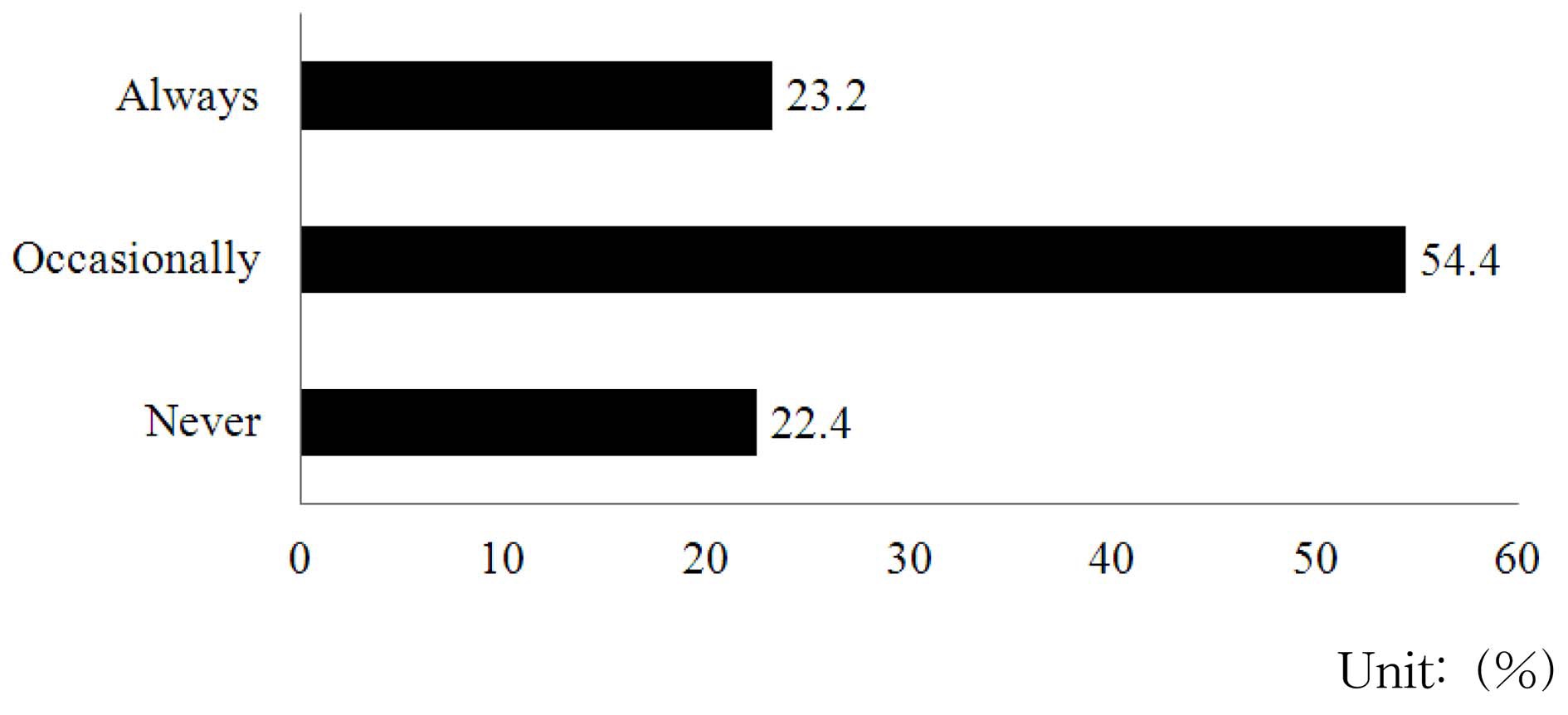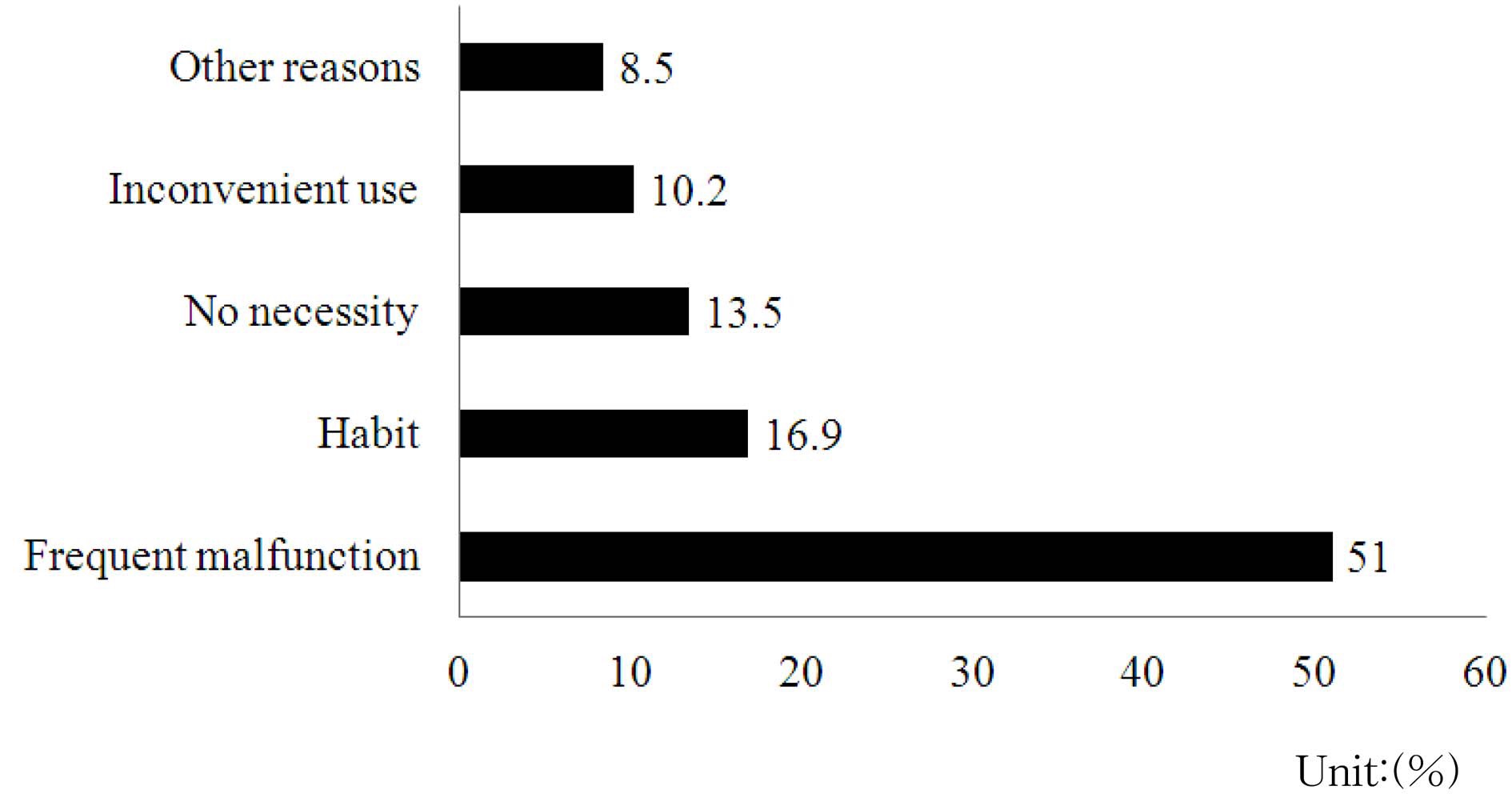



This study aims to suggest practical considerations for designing protective clothing with increased visibility that will have higher user acceptance by law enforcement officers. Light-emitting diode(LED) patrol vests were visually and structurally assessed, and 125 police officers’ responses from surveys about user acceptance of the vest were analyzed. The current LED patrol vest was designed for enhanced safety of police officers by increasing visibility in the dark. However, the user acceptance rate of the LED patrol vest indicates low use of and low satisfaction with the vest despite its enhanced safety features. In particular, differences in materials, design, functionality of the pockets and size of the vest depending on the hours worked, were statistically significant. The police officers’ responses suggest areas of improvement in design, materials, ease of movement, size and functionality. Key issues include ‘tactile discomfort’; ‘impeded vision from the glare of the LED’; ‘frequent malfunctions of the LED’; ‘impossible repair of the broken LED units’; ‘no user feedback’; ‘inconvenient to replace batteries’; ‘brittle materials’ and ‘unpleasing look’. To increase user acceptance, designer should incorporate context-awareness, a convenient user interface, a modular design approach, first responders’ self-image as public servants in relation to their aesthetic perspectives of their uniforms, and scientific evaluation of the effectiveness of the intended functions of the clothing. Suggested implications for designing the LED patrol vest can be applied to designing other functional/protective clothing for intended end users with special needs.
More than one million people around the globe die every year on roads, and over 20 million suffer road traffic injuries(World Health Organization, 2009). In Korea, where the registered units of cars are reaching 200 million (“Car”, 2013), over 200,000 traffic accidents occur and over 5,000 people die of traffic accidents every year(Road Traffic Authority, 2012).
Low luminance and visibility at night dramatically increase the number of deaths and fatal injuries of people who are hit by vehicles on roads(Plainis, Murray and Pallikaris, 2006). In particular, first responders, such as law enforcement officers who work on roads, are vulnerable to the environmental challenge of working near moving vehicles. Kang(2009) reported that the number of traffic accidents was greater at night (after 10pm) while the visibility is low on the road. A review of literature reveals that dark, low-contrast clothing is a contributing factor to road traffic accidents at night because drivers’ eyes respond to those garment conditions slowly, and this impedes quick reactions for stopping a vehicle in an emergency(Plainis, Murray and Pallikaris, 2006). For this reason, in many countries police officers who are engaged in a range of traffic activities wear high-visibility vests or jackets with lightreflective trim.
To increase visibility on roads, reflective tape has been widely used not only on traffic law enforcement personnel’s patrol vests but also on the garments for joggers, cyclists, construction workers, etc. because the reflective tape made of polyester or polyester blend with cotton is washable, sew-able and relatively inexpensive. However, it is almost impossible to increase visibility without an external light source reflecting on the tape(Kim, 2010).
Recently developed light emitting diode(LED) technology began to be incorporated into clothing as a safety feature because LEDs can provide increased visibility regardless of the environmental light conditions. LED is known as a relatively inexpensive technology that generates its maximum luminance faster and is more durable against impact shock than conventional light bulbs(Lee, 2008). As industries become more aware of its positive impacts of energy efficient high luminescent features on safety, the LED technology is used not only to improve safety, but also to provide value-added functionalities to conventional clothing(Gould, 2003). For example, Philips Inc. introduced emotional responsive clothing by embedding biosensors and LEDs. The clothing was designed to reflect the wearer’s emotion based on characteristics of bio-signals collected in the wearer’s different emotional states. In addition, the sportswear industry began to incorporate LEDs for increased visibility for runners, cyclists, joggers, and skiers who need visibility safety features(Gould, 2003).
Considering the LED’s technological merits such as energy-efficient high luminance and durability, the use of LEDs is also expected to provide enhanced safety for police officers working on roads at night than conventional reflective trims do because of its capability of flashing lights. In terms of the effectiveness of increasing visibility, Wood et al.(2009), their experimental study, reported that flashing lights on cyclists showed slightly higher perception of visibility than attaching reflective trims both in daytime and at night.
Recently, in South Korea, patrol vests equipped with LEDs have been given to police officers for enhanced protection. The integration of LED technology is intended to enhance personal protection. For police officers and other first responders, the given uniform that they are wearing is, in many cases, the only, and irreplaceable protection. It functions as armor, a buffer, or sometimes an insulator from environmental hazards in officers’ given work conditions, in which there are limited or no alternatives for protection. Improved designs with enhanced safety features in protective clothing can improve the safety and work efficiency of police officers. Therefore, it is imperative to assess the officers’ acceptance of and requests regarding their protective clothing in order to understand their needs and to then be able to increase their safety and efficiency on the job. Considering the fact that police officers are typically required to wear items provided by their governing organizations through an official procurement process, it is important to reflect the wearers’ needs in the design.
This study assesses the shape and the structure of current LED patrol vest, and traffic law enforcement officers’ acceptance of a LED patrol vest used by the police in South Korea; in addition, it evaluates the suggestions that the officers in the study offered for improvement of the vest based on their experiences with it. The aim of this study is to suggest practical considerations for designing protective clothing with increased visibility and higher user acceptance

Survey questions
2.1. Analysis of LED patrol vests
Researchers identified the LED patrol vests through on-site visits to police departments in the southern area of South Korea. The structure of the electric components for the LED operation and the design features were visually analyzed. The analysis was carried out in two steps. The researchers visited the police office and photographed and studied the image of a policeman wearing a LED patrol vest and the detailed image of the outside and the inside of the vest. Then, the researchers disassembled the LED vest and analyzed the detailed structure.
2.2. Survey of user acceptance
The initial survey questions were developed based on interviews with police officers and previous studies about user acceptance of protective apparel by Kim and Suh(2002, 2003) and Lim et al.(2006, 2008). A pre-test was conducted with 50 police officers. After the pre-test, the wording of the questionnaire was revised to clarify the instructions and questions. The revised survey was used for data collection in South Korea; the researchers visited a police training institute and conducted the survey with the permission of the organization. Participation in the survey was voluntary.
The first part of the survey contained three general questions about the respondents: age, duration of work as a traffic police officer, and average daily work hours on roads. The next part asked about the respondents’ acceptance of the LED patrol vest, including their experience and satisfaction with the LED vest, their reasons for their dissatisfaction, and their needs for improved comfort and design for the vest, as shown in Table 1. All questions were multiple choices, but open-ended comments were included to ensure that the participants’ responses were not limited to the choices given by the researchers. Out of 250 surveys, only 125 responses were analyzed, collected from police officers who had experience wearing the LED patrol vest.
The data were analyzed using multiple response analysis. Oneway ANOVA and multiple comparison tests were also used to identify a significant relationship between the participants’ work hours and satisfaction with the vest using PASW Statistics 18.0. Participants’
[Table 2.] LED patrol vests for traffic police officers
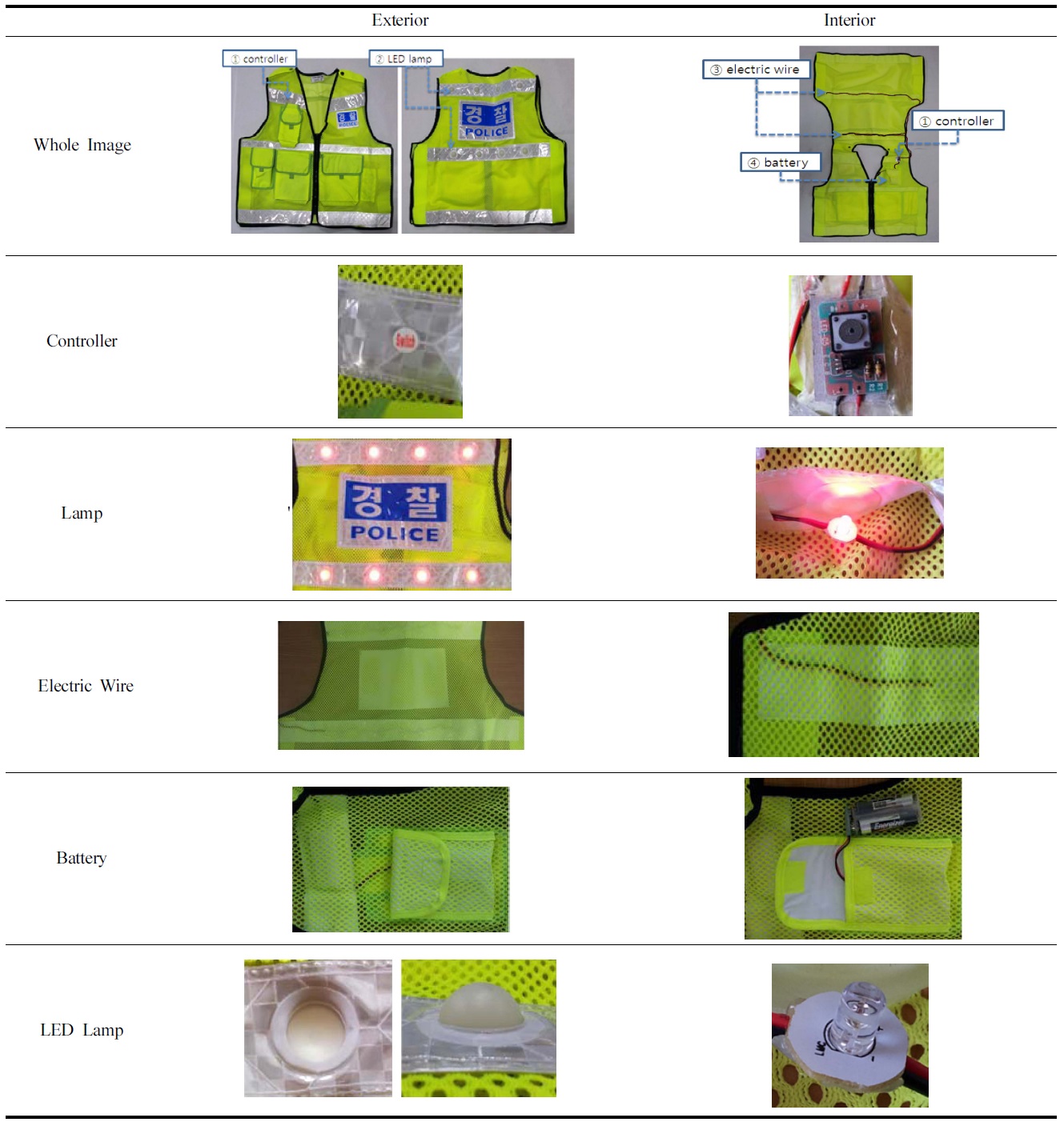
LED patrol vests for traffic police officers
open-ended comments were also included in the analysis.
3.1. Analysis of LED patrol vests
In this study, the LED patrol vest that the police officers wore has three wide light-reflective tapes attached to the front and back of the vest, which was made of mesh, as shown in Table 2.
A total of eight LEDs are located on the back of the vest; four LEDs are placed on each line of the light reflective tape around the shoulder and the mid-back. The placement of LEDs only on the back is expected to increase battery consumption because if the police officers cannot see whether the LEDs are on or off, they are less likely to pay attention to the need to turn them on and off, depending on the environmental light conditions. Each LED (diameter: 0.4 cm, height: 0.6 cm) emits a red light and is covered by a hemisphere-shaped plastic capsule (diameter: 2 cm, height: 0.8 cm) to reduce glare from the LED. The capsule also protects the LEDs from ambient humidity and damaging physical contact. The LED function is operated by a toggle switch; pressing the switch once turns on the LEDs to flash at one second intervals, and pressing the switch once more turns them off. Two 1.5 voltage AA batteries are connected to the LEDs and an on/off controller(dimension: 3 cm×2 cm×0.5 cm) through wires. The two batteries are located inside a patch pocket (dimension: 9 cm×10 cm) and the wearers are encouraged to replace the old batteries with new ones when needed. The batteries can cause inconvenience for wearers because they are little heavy and impossible to reuse. Therefore, light-weighted and rechargeable batteries could be a better option.
3.2. Information about participants
All the respondents were male police officers, and a majority of them were in their 30s(42.4%) and 40s(44.8%), as shown in Table 4 73.6% of the respondents had less than five years of work experience as traffic police 82.4% of the respondents reported that they work more than five hours a day on roads (Table 2), 48% of the respondents reported 5-10 hours of work a day, and 34.4% more than 10 hours.
3.3. User acceptance of the LED patrol vest
Experience of wearing LED vests: 77.6% of the survey participants reported that they used the LED function(Table 4): 54.4% of
[Table 3.] Schematic diagrams of LED patrol vests
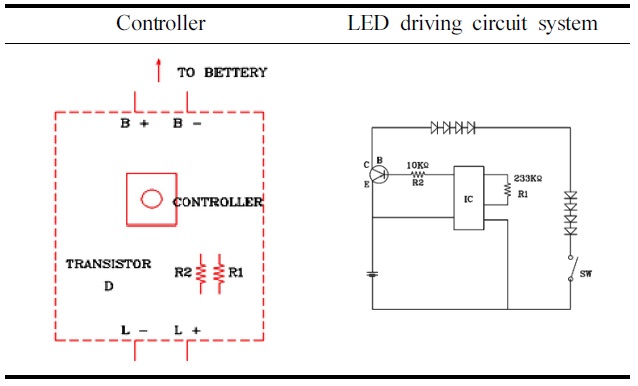
Schematic diagrams of LED patrol vests
[Table 4.] Information about respondents
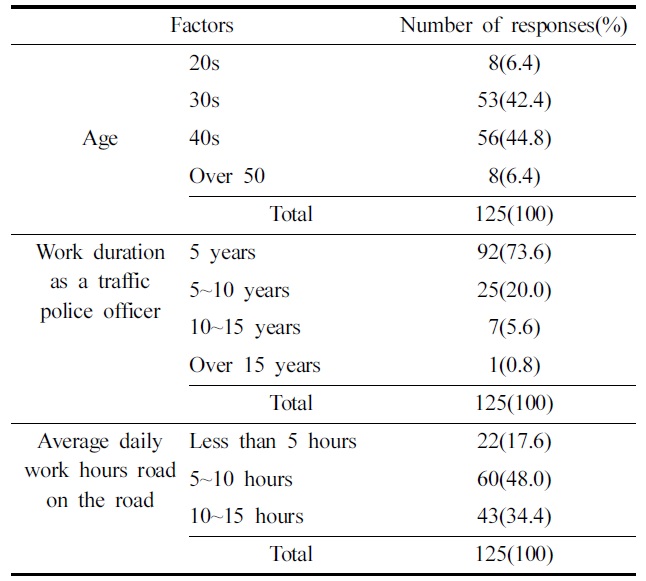
Information about respondents
the participants used it occasionally, while only 23.2% used it all the time. However, 22.4% of the participants reported that they never used it. There was no statistically significant difference in the usage of the LED function among three different work hour groups.
Reasons for no/less use of the LED function: This includes “frequent malfunction of LED(51.0%)”; “habitually didn’t use (16.9%)”; “felt it was not necessary(13.5%)”; and “inconvenient to use(10.2%)”; as shown in Fig. 2. In particular, the inconvenient location of the switch, frequent battery changes, and not being able to see the LEDs on the back of the vest were given as detailed reasons for the inconvenience of use. Other reasons(8.5%) included “need to purchase batteries”; and “uncomfortable feeling of wearing a flashing LED vest.”
Satisfaction with the current LED patrol vest: Satisfaction with the vest was assessed using a 5-point Likert-type scale in terms of design, materials, ease of movement, functionality of pockets, and the size of the vest, as shown in Table 5. The longer the police officers worked, the less satisfied they tended to be with the vest
[Table 5.] Results of one-way ANOVA regarding the participants’ satisfaction with the vest
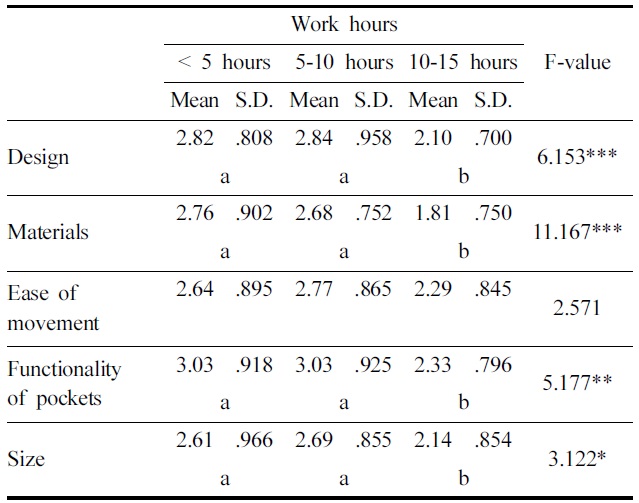
Results of one-way ANOVA regarding the participants’ satisfaction with the vest
regarding the five factors asked about in the survey. In particular, differences in materials, design, functionality of the pockets and size depending on the hours worked, were statistically significant. In all the factors the police officers’ response showed low satisfaction level(below 3 points on average in 5 point Likert scale), which implies a need for an further understanding of reasons for dissatisfaction for improvement in user acceptance.
A total of 85 open-ended responses indicate specific reasons for dissatisfaction with the vest and further needs, shown as follows.
[Table 6.] Perceived contribution of LED to the safety on roads
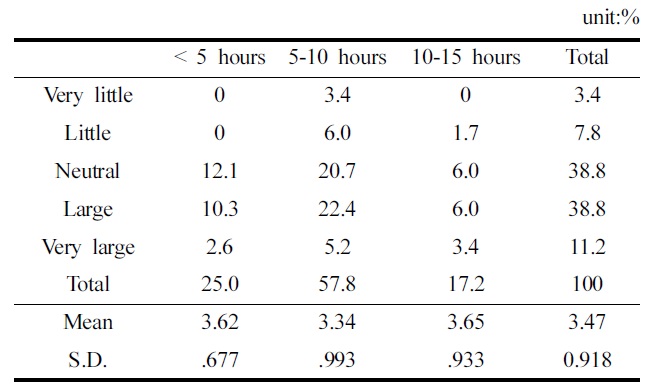
Perceived contribution of LED to the safety on roads
In this study, the visual shape and the structure of the LED patrol vest currently worn by traffic police officers were assessed, and usages and acceptances on LED patrol vests were investigated from actual users. Also, the problems of LED patrol vests and the demands were investigated through the survey and open-ended responsesto give useful information for patrol uniform design for improved safety and comfort for police officers.
Visual and technical assessment of LED patrol vest identified the enhanced safety features, which may be helpful to reduce injuries and accidents of police working in the dark by increasing their visibility; The current police LED patrol vests were constructed with 3 layers of luminous reflective tapes in front and back, 2 layers of 8 LED lamps on the back, and the entire neon-colored net for enhanced visibility. However, some technical problems were found such as needs for battery replacement or recharging, and unawareness of on/off of the LED. Despite the respondents’ high acknowledgement of enhanced safety feature, the findings of this study indicate the user acceptance of LED patrol vest was low. This implies that the police officers who participated had needs for improvements in the design of the vest.
A statistical analysis found a significant correlation between hours of duty and satisfaction; an increase in working hours resulted in significantly lower satisfaction with design, materials, functionality of pockets and the size of the vest. This result implies that increased user experience leads to lower satisfaction with the vest, indicating the needs for improved design of the LED patrol vest.
The current study further identified areas of improvement through survey and open-ended questions.
Key design issues for improved user acceptance encompass design, ease of movement, materials, functionality of pockets and size of the vest, as shown in following keywords: “tactile discomfort due to bulky LED protection cap”; “impeded vision from the glare of the LEDs”; “inability to repair or replace the malfunctioning LEDs due to non-separable design of electric unit”; “frequent malfunctions of LEDs”; “no information about LED’s on/off status due to inconvenient location of LEDs”; “inconvenience of replacing batteries frequently”; “Brittle materials”; and “unpleasing look”.
These findings provide practical implications for designing improved vests for police officers. First, designers need to understand the intended end-users’ (police officers in this study) work environments, required activities for law enforcement on roads, and context to improve user acceptance of the design. A convenient user interface should also be considered to make the wearer aware of the operation of the intended functions. A modular design approach should be taken for convenient maintenance. Easily detachable design features will allow for easy repair and replacement of broken electrical parts. The findings of this study also show a discrepancy between police officers’ endorsement of enhanced visibility aids and their actual use, which was consistent with results of previous studies(Hagel et al., 2007; Wood et al., 2007). Therefore, this study suggests that police officers should be educated about the importance of having visibility aids.
In designing the LED vest or even other garments for police officers, designers need to take into serious consideration the police officers’ self-image as law enforcement personnel working in public spaces. In this study, respondents showed their low satisfaction with the appearance of “light-flashing garment”. This may contribute to a low rate of use of the LED patrol vest among police officers even though they may understand that LED functions can provide increased visibility on the road. Last, scientific evaluation of design effectiveness on increased visibility and decreased accidents in comparison to existing light-reflective patrol vests without LED functions needs to be done. Those future studies are expected to provide a clear understanding of the effectiveness of LED functions, which may help police officers decide whether to use them or not.
This study focused on an analysis of user acceptance of one of the commonly used current LED patrol vests and suggested practical implications for improvement of the design to increase user acceptance. Although the study investigated only one product, the implications of this study may be applied to designing other functional clothing for intended end-users with special needs.




